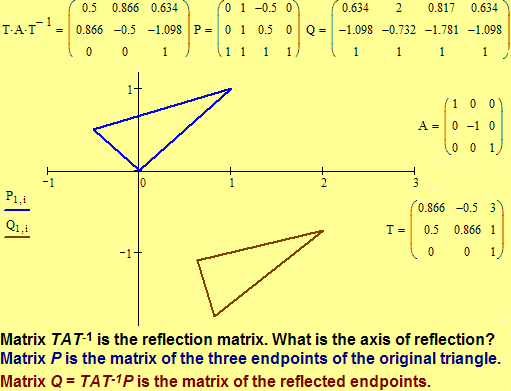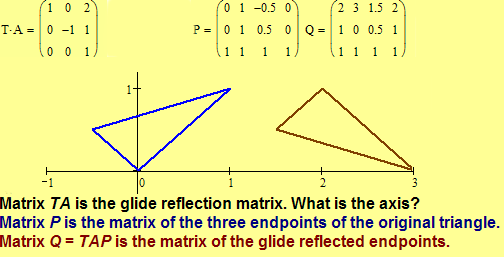3.5.2 Reflection of the Analytic Euclidean
Plane Model
![]() Printout
Printout
Nature
often holds up a mirror so we can see more clearly the ongoing processes of
growth, renewal, and transformation
in our lives.
—Mary Ann Brussat
The
investigations from the last section indicate that a
reflection of the
Euclidean plane is an indirect isometry.
![]() What form does the matrix of an affine
reflection of the Euclidean plane have? Let's investigate that question. To
simplify the problem, we first consider the problem with the line h[0, 1, 0] (the x-axis) as the
axis of reflection. Let
X(x1, x2, 1) be an arbitrary
point in the Euclidean plane with image X'
under the reflection Rh.
What form does the matrix of an affine
reflection of the Euclidean plane have? Let's investigate that question. To
simplify the problem, we first consider the problem with the line h[0, 1, 0] (the x-axis) as the
axis of reflection. Let
X(x1, x2, 1) be an arbitrary
point in the Euclidean plane with image X'
under the reflection Rh.
Since every point on h is invariant and has the form X(x1, 0 , 1), we must have x1 = a11x1 + a13 and 0 = a21x1 + a23. Thus, since (0, 0, 1) is on h, a13 = 0 and a23 = 0. And, since (1, 0, 1) is on h, a11 = 1 and a21 = 0. Since Rh maps the point (0, 1, 1) to (0, –1, 1), a12 = 0 and a22 = –1. Hence,
We need to show that A
is the matrix of the reflection Rh.
Matrix A maps an arbitrary point X(x1, x2, 1) to the point X'(x1, x2, 1). If X is on h, then x2 = 0 and X' is on h. If X
is not on h, then the midpoint (x1, 0, 1) of segment XX' is on h and the
line through X and X' is l [1, 0, –x1].
Since 0(1) + 1(0) = 0,
by the definition of the
measure of an angle
between two lines. Therefore, A is
the matrix of the reflection Rh.
Since det(A) = –1, the reflection Rh is an indirect isometry.
What is the form
of the matrix for a reflection Rl
other than Rh? We can
apply a method similar to the method used with a rotation that was not centered
at the origin. If l is parallel to h, use a translation T that translates h to l and define .
If l is not parallel to h, then l and h intersect at some
point P, use a rotation
that translates h to l and define
.
We summarize our results above and
from the previous section with the following proposition.
Proposition 3.15. (a) An affine reflection of the Euclidean plane is an indirect isometry. (b) Any affine indirect isometry of the Euclidean plane with exactly one line with all points invariant under the isometry is a reflection. (c) The matrix representation of an affine reflection of the Euclidean plane with axis h[0, 1, 0] is
(d) The matrix representation of an affine reflection of the Euclidean
plane with axis l distinct from h is where T
is a direct isometry that maps line h to line l.


Exercise 3.80. Find a matrix of the reflection Rl where
(a) l[1,
–1,
0] (b) l[0, 1, –4], then for each reflection find the image of (4, 4, 1) and
Exercise 3.81. Find a matrix of the reflection Rl where ,
and find the image of (2, 8, 1), (4, 4, 1), and (10, 7, 1).
Exercise 3.82. Find a matrix of the reflection that maps the point X(3, 8, 1) to Y(5, 1, 1) and find the image of Z(12, 7, 1).
Exercise
3.83. Find a matrix of the reflection that maps the line l[2, 3, –1] to m[2, 3, 5].
Exercise 3.84. Find a product of reflections that maps X(–2, 5, 1), Y(–2, 7, 1), and Z(–5, 5, 1) to X'(4, 3, 1), Y'(6, 3, 1), and Z'(4, 0, 1).
Exercise 3.85. Verify part (d) of Proposition 3.15.
|
3.5.1 Reflections and Glide Reflections |
|
© Copyright 2005, 2006 - Timothy Peil |